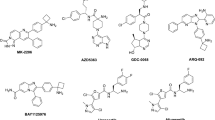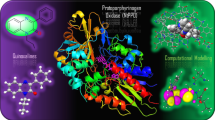Abstract
A series of 6-arylamino-7-chloro-quinazoline-5,8-diones have been evaluated as novel human topoisomerase I (TOP1) inhibitors based on the antitumor activity of 1,4-naphthoquinone. Besides theirin vitro cytotoxicity, their ability to inhibit human TOP1-DNAin vitro was tested with human TOP1 and a supercoiled (Form I) plasmid substrate DNA (Parket ai., 2004). Using the flexible docking program, QXP, we have developed ternary complex models by docking camptothecin and ten 6-arylamino-7-chloro-quinazoline-5,8-dione analogs into the X-ray crystal structure of the human TOP1-DNA binary complex. The compound binding modes substantiated their potential inhibitory activities against TOP1 in the relaxation assay. Compounds whose templates the 6-arylamino-7-chloro-quinazoline-5,8-dione moiety intercalated between the -1 and +1 base pairs of the scissile strand showed good inhibitory activities. The template of compounds with poor inhibitory activities intercalated between the DNA base pairs of the non-scissile strand. The interaction of the compounds and the human TOP1-DNA binary complex were stabilized by an array of hydrogen bonds and hydrophobic interactions with the TOP1 residues, DNA bases, and water molecules. Docking results from the QXP program suggested potential binding modes of each non-CPT type compound in the human TOP1-DNA cleavable complex, which could provide a rational basis for future TOP1 inhibitor development.
Similar content being viewed by others
References
Bailly, C., Topoisomerase I poisons and suppressors as anti-cancer drugs.Curr. Med. Chem., 7, 39–58 (2000).
Capranico, G. and Binaschi, M., DNA sequence selectivity of topoisomerases and topoisomerase poisons.Biochim. Biophys. Acta., 1400, 185–194 (1998).
Cho, W. -J., Min, S. Y., Le, T. N., and Kim, T. S., Synthesis of new 3-arylisoquinolinamines: effect on topoisomerase I inhibition and cytotoxicity.Bioorg. Med. Chem. Lett., 13, 4451–4454 (2003).
Chrencik, J. E., Staker, B. L, Burgin, A. B., Pourquier, P., Pommier, Y., Stewart, L., and Redinbo, M. R., Mechanisms of campto-thecin resistance by human topoisomerase I mutations.J. Mol. Biol., 339, 773–784 (2004).
Cotesta, S., Giordanetto, F., Trosset, J. -Y, Crivori, P., Kroemer, R. T., Stouten, P. F. W., and Vulpetti, A., Virtual screening to enrich a compound collection with CDK2 inhibitors using docking, scoring, and composite scoring models.Proteins, 60, 629–643 (2005).
Dallavalle, S., Merlini, L, Morini, G., Musso, L, Penco, S., Beretta, G. L, Tinelli, S., and Zunino, F., Synthesis and cyto- toxic activity of substituted 7-aryliminomethyl derivatives of camptothecin.Eur. J. Med. Chem., 39, 507–513 (2004).
Del Poeta, M., Chen, S. F., Von Hoff, D., Dykstra, C. C., Wani, M. C., Manikumar, G., Heitman, J., Wall, M. E., and Perfect, J. R., Comparison of in vitro activities of camptothecin and nitidine derivatives against fungal and cancer cells.Anti-microb. Agents Chemother., 43, 2862–2868 (1999).
Fan, Y., Weinstein, J. N., Kohn, K. W., Shi, L. M., and Pommier, Y., Molecular modeling studies of the DNA-topoisomerase I ternary cleavable complex with camptothecin.J. Med. Chem., 41, 2216–2226 (1998).
Interthal, H., Quigley, P. M., Hol, W. G., and Champoux, J. J., The role of lysine 532 in the catalytic mechanism of human topoisomerase I.J. Biol. Chem., 279, 2984–2992 (2004).
Kellenberger, E., Rodrigo, J., Muller, P., and Rognan, D., Comparative Evaluation of Eight Docking Tools for Docking and Virtual Screening Accuracy.Proteins, 57, 225–242 (2004).
Kerrigan, J. E. and Pilch, D. S., A structural model for the ternary cleavable complex formed between human topoisomerase I, DNA, and camptothecin,Biochemistry, 40, 9792–9798 (2001).
Kerrigan, J. E., Pilch, D. S., Ruchelman, A. L., Zhou, N., Liu, A., Liu, L., and La Voie, E. J., 5H-8,9-Dimethoxy-5-(2-N,N-di- methylaminoethyl)dibenzo[c,h][1 and 6]naphthyridin-6-ones and related compounds as TOP1-targeting agents: influence of structure on the ternary cleavable complex formation.Bioorg. Med. Chem. Lett., 13, 3395–3399 (2003).
Kettmann, V., Kost’alova, D., and Holtje, H. D., Human topoisomerase I poisoning: docking protoberberines into a structure- based binding site model.J. Comput. Aided. Mol. Des., 18, 785–796 (2004).
Kjeldsen, E., Svejstrup, J. Q., Gromova, II., Alsner, J., and Westergaard, O., Camptothecin inhibits both the cleavage and religation reactions of eukaryotic DNA topoisomerase I.J. Mol. Biol., 228, 1025–1030 (1992).
Laco, G. S., Collins, J. Ft., Luke, B. T., Kroth, H., Sayer, J. M., Jerina, D. M., and Pommier, Y., Human topoisomerase I inhibition: docking camptothecin and derivatives into a structurebased active site model.Biochemistry, 41, 1428–1435 (2002).
Lauria, A., Ippolito, M., and Almerico, A. M., Molecular docking approach on the Topoisomerase I inhibitors series included in the NCI anti-cancer agents mechanism database.J. Mol. Model, 13, 393–400 (2007).
Marco, E., Laine, W., Tardy, C., Lansiaux, A., Iwao, M., Ishibashi, F., Bailly, C., and Gago, F., Molecular determinants of topoisomerase I poisoning by lamellarins: Comparison with camptothecin and structure-activity relationships.J. Med. Chem., 48, 3796–3807 (2005).
McMartin, C. and Bohacek, R. S., QXP: Powerful, rapid computer algorithms for structure-based drug design.J. Comput. Aided Mol. Des., 11, 333–344 (1997).
Park, H. J., Kim, Y. S., Kim, J. S., Lee, E. J., Yi, Y. J., Hwang, H. J., Suh, M. E., Ryu, C. K., and Lee, S. K., 6-Arylamino-7-chloro- quinazoline-5,8-diones as novel cytotoxic and DNA topoisomerase inhibitory agents.Bioorg. Med. Chem. Lett., 14, 3385–3388 (2004).
Pommier, Y, Pourquier, P., Fan, Y., and Strumberg, D., Mechanism of action of eukaryotic DNA topoisomerase I and drugs targeted to the enzyme.Biochim. Biophys. Acta., 1400, 83–106 (1998).
Pommier, Y., Kohlhagen, G., Laco, G. S., Kroth, H., Sayer, J. M., and Jerina, D. M., Different effects on human toposiomerase I by minor groove and intercalated deoxyguanosine adducts derived from two polycyclic aromatic hydrocarbon diol epoxides at or near a normal cleavage site.J. Biol. Chem., 277, 13666–13672 (2002).
Redinbo, M. R., Champoux, J. J., and Hol, W. G., Novel insights into catalytic mechanism from a crystal structure of human topoisomerase I in complex with DNA.Biochemistry, 39, 6832–6840 (2000).
Staker, B. L., Hjerrild, K., Feese, M. D., Behnke, C. A., Burgin, A. B., and Stewart, L., The mechanism of topoisomerase I poisoning by a camptothecin analog.Proc. Natl. Acad. Sci., 99, 15387–15392 (2002).
Staker, B. L., Feese, M. D., Cushman, M., Pommier, Y., Zembower, D., Stewart, L., and Burgin, A. B., Structures of three classes of anticancer agents bound to the human topoisomerase I-DNA covalent complex.J. Med. Chem., 48, 2336–2345 (2005).
Silverman, R. B., The organic chemistry of drug design and drug action. Academic Press, San Diego, CA, USA (2004).
Urasaki, Y., Laco, G. S., Pourquier, P., Takebayshi, Y., Kohlhage, G., Gioffre, C., Zhang, H., Chatterjee, D., Pantazis, P., and Pommier, Y., CharActarization of a novel topoisomerase I mutation from a camptothecin-resistant human prostate cancer cell line.Cancer Res., 61, 1964–1969 (2001).
Author information
Authors and Affiliations
Corresponding author
Rights and permissions
About this article
Cite this article
Choi, I., Kim, C. & Choi, S. Binding mode analysis of topoisomerase inhibitors, 6-arylamino-7-chloro-quinazoline-5,8-diones, within the cleavable complex of human topoisomerase I and DNA. Arch Pharm Res 30, 1526–1535 (2007). https://doi.org/10.1007/BF02977321
Received:
Issue Date:
DOI: https://doi.org/10.1007/BF02977321




